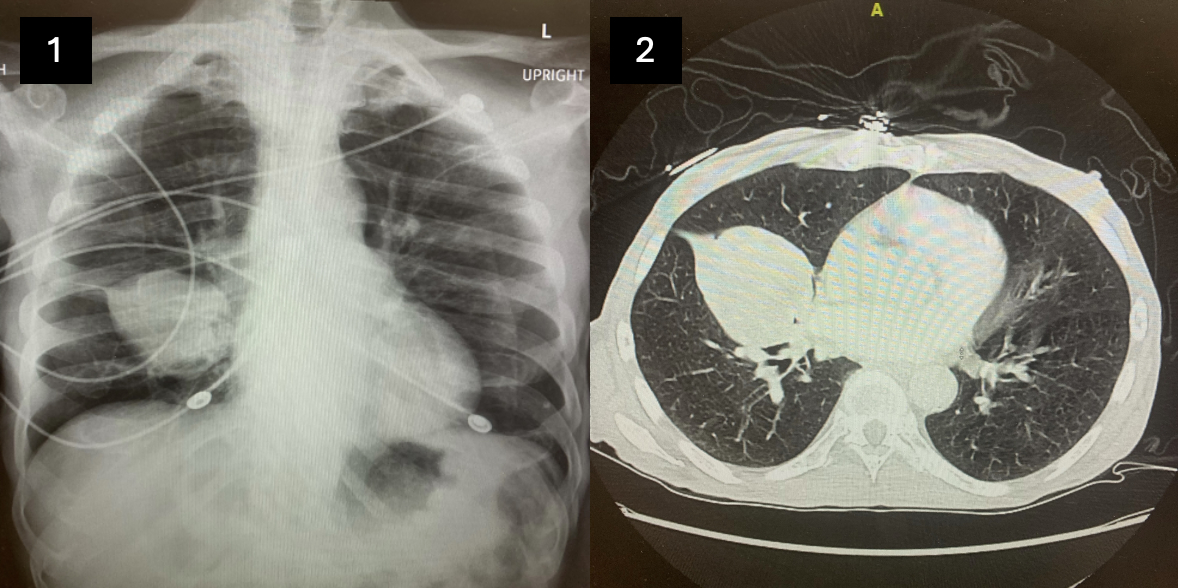Tuesday Poster Session
Category: Functional Bowel Disease
P4077 - Paraneoplastic Diarrhea in Lung Adenocarcinoma: Is Chromogranin A the Mediator?
Tuesday, October 29, 2024
10:30 AM - 4:00 PM ET
Location: Exhibit Hall E

Has Audio

Matthew Posen, DO
Advocate Christ Medical Center
Oak Lawn, IL
Presenting Author(s)
Matthew Posen, DO, George Kalapurakal, DO, Krishna Shah, MD, Ahmad Mardini, MD, Harreth Raddawi, MD
Advocate Christ Medical Center, Oak Lawn, IL
Introduction: Lung cancers are associated with several paraneoplastic syndromes; chronic diarrhea is not a well-documented occurrence. In prior literature, only two cases of paraneoplastic diarrhea due to lung adenocarcinoma have been reported. Herein, we present a probable third case of this rare paraneoplastic syndrome.
Case Description/Methods: An 84-year-old male with a 70-pack-year smoking history presented to the emergency room with six months of diarrhea and unintentional weight loss. The patient approximated six watery stools per day that were unrelated to food consumption, along with nocturnal diarrhea. Labs were notable for potassium of 2.2 mmol/L. Computerized Tomography of Chest Abdomen and Pelvis with contrast demonstrated a 5.2 cm x 7.5 cm right middle lobe mass without noted metastasis. Biopsy of the lung mass was completed with preliminary pathology concerning for a carcinoid tumor. 5-hydroxyindoleacetic acid (5-HIAA) was unable to be quantitated but a Chromogranin A level returned at 300 ng/mL. Infectious, inflammatory and malabsorptive work up of diarrhea was unremarkable. Colonoscopy demonstrated three benign polyps. The final pathology of the lung biopsy revealed poorly differentiated adenocarcinoma.
Discussion: Carcinoid syndrome is a well-known cause of diarrhea usually requiring liver metastases preventing proper hepatic elimination of the bioactive peptides and amines such as serotonin, histamine, tachykinins, and prostaglandins released from the carcinoid tumor. Chronic diarrhea presenting as part of a paraneoplastic process of lung adenocarcinoma has only been described twice in the literature with both cases positing elevation of Chromogranin A as the likely mechanism of the diarrhea. A 2018 Inflammatory Bowel Disease study proposed a mechanism for Chromogranin A with involvement in immune modulation via cytokine release and movement of intracellular calcium and subsequent peristalsis. Increasing the complexity of function, twelve different receptors to Chromogranin A have been identified in gastrointestinal neuroendocrine cells. Much more has yet to be discovered regarding paraneoplastic effects and their relation to common complaints such as diarrhea. With further understanding, earlier diagnosis and treatment of underlying malignancy would play a key role in outcomes.

Disclosures:
Matthew Posen, DO, George Kalapurakal, DO, Krishna Shah, MD, Ahmad Mardini, MD, Harreth Raddawi, MD. P4077 - Paraneoplastic Diarrhea in Lung Adenocarcinoma: Is Chromogranin A the Mediator?, ACG 2024 Annual Scientific Meeting Abstracts. Philadelphia, PA: American College of Gastroenterology.
Advocate Christ Medical Center, Oak Lawn, IL
Introduction: Lung cancers are associated with several paraneoplastic syndromes; chronic diarrhea is not a well-documented occurrence. In prior literature, only two cases of paraneoplastic diarrhea due to lung adenocarcinoma have been reported. Herein, we present a probable third case of this rare paraneoplastic syndrome.
Case Description/Methods: An 84-year-old male with a 70-pack-year smoking history presented to the emergency room with six months of diarrhea and unintentional weight loss. The patient approximated six watery stools per day that were unrelated to food consumption, along with nocturnal diarrhea. Labs were notable for potassium of 2.2 mmol/L. Computerized Tomography of Chest Abdomen and Pelvis with contrast demonstrated a 5.2 cm x 7.5 cm right middle lobe mass without noted metastasis. Biopsy of the lung mass was completed with preliminary pathology concerning for a carcinoid tumor. 5-hydroxyindoleacetic acid (5-HIAA) was unable to be quantitated but a Chromogranin A level returned at 300 ng/mL. Infectious, inflammatory and malabsorptive work up of diarrhea was unremarkable. Colonoscopy demonstrated three benign polyps. The final pathology of the lung biopsy revealed poorly differentiated adenocarcinoma.
Discussion: Carcinoid syndrome is a well-known cause of diarrhea usually requiring liver metastases preventing proper hepatic elimination of the bioactive peptides and amines such as serotonin, histamine, tachykinins, and prostaglandins released from the carcinoid tumor. Chronic diarrhea presenting as part of a paraneoplastic process of lung adenocarcinoma has only been described twice in the literature with both cases positing elevation of Chromogranin A as the likely mechanism of the diarrhea. A 2018 Inflammatory Bowel Disease study proposed a mechanism for Chromogranin A with involvement in immune modulation via cytokine release and movement of intracellular calcium and subsequent peristalsis. Increasing the complexity of function, twelve different receptors to Chromogranin A have been identified in gastrointestinal neuroendocrine cells. Much more has yet to be discovered regarding paraneoplastic effects and their relation to common complaints such as diarrhea. With further understanding, earlier diagnosis and treatment of underlying malignancy would play a key role in outcomes.

Figure: Figure 1: Chest X-Ray image revealing right lung mass. Figure 2: CT Chest further demonstrating right middle lung lobe mass.
Disclosures:
Matthew Posen indicated no relevant financial relationships.
George Kalapurakal indicated no relevant financial relationships.
Krishna Shah indicated no relevant financial relationships.
Ahmad Mardini indicated no relevant financial relationships.
Harreth Raddawi indicated no relevant financial relationships.
Matthew Posen, DO, George Kalapurakal, DO, Krishna Shah, MD, Ahmad Mardini, MD, Harreth Raddawi, MD. P4077 - Paraneoplastic Diarrhea in Lung Adenocarcinoma: Is Chromogranin A the Mediator?, ACG 2024 Annual Scientific Meeting Abstracts. Philadelphia, PA: American College of Gastroenterology.
